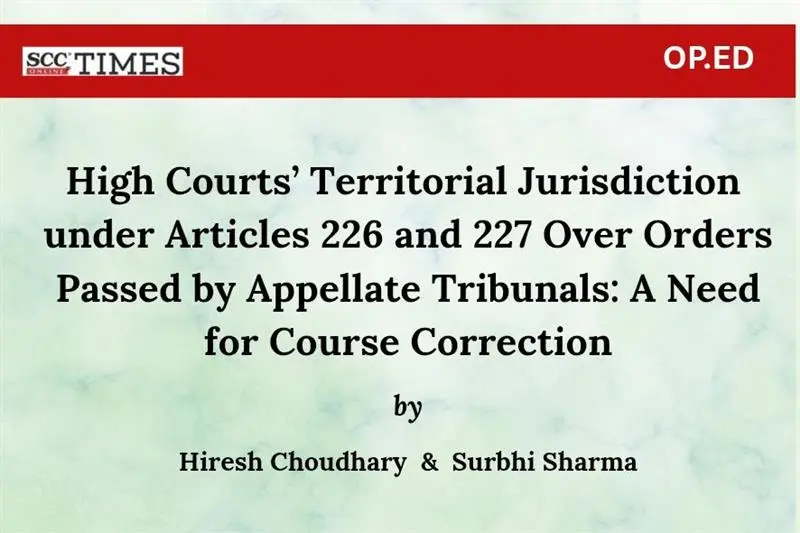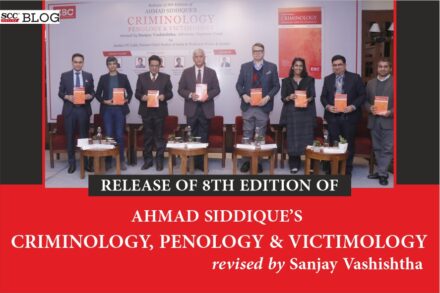Introduction
Pursuant to Articles 2261 and 2272 of the Constitution of India3, there are two ways in which a High Court could exercise territorial jurisdiction over entities (including a person, authority, government, court or tribunal): (i) they are situated within the territorial jurisdiction of the High Court (situs doctrine); or (ii) the cause of action arose within the territorial jurisdiction of the High Court (cause of action doctrine).
This article examines the current approach to law regarding territorial jurisdiction of High Courts over orders passed by appellate authorities and tribunals. It chronicles the evolving approach taken by the Supreme Court in its judgments in Kusum Ingots & Alloys Ltd. v. Union of India4, Ambica Industries v. CCE5, and Calcutta Gujarati Education Society v. EPFO6 wherein the Supreme Court has reached the finding that the cause of action doctrine applies to the exclusion of the situs doctrine. It further notes the divergent approach adopted by several High Courts which continue to apply the situs doctrine by holding that the order of an appellate authority/tribunal itself gives rise to material cause of action.
(i) Textual analysis of Articles 226 and 227
Article 226(1) empowers the High Court to issue directions, orders or writs to any person or authority, including in appropriate case, any government, within the territories in relation to which it exercises jurisdiction. Article 226(2) further provides that:
226(2). The power conferred by clause (1) to issue directions, orders or writs to any government, authority or person may also be exercised by any High Court exercising jurisdiction in relation to the territories within which the cause of action, wholly or in part, arises for the exercise of such power, notwithstanding that the seat of such government or authority or the residence of such person is not within those territories.
A plain reading of Article 226 suggests that clause (1) confers territorial jurisdiction to High Court based on the situs doctrine, while clause (2) confers the same based on the cause of action doctrine. There is no textual basis to suggest that one shall apply over the other, whether in relation to orders passed by appellate authorities or otherwise.
In contrast, Article 227(1) states: “Every High Court shall have superintendence over all courts and tribunals throughout the territories in relation to which it exercises jurisdiction.” There is no equivalent to clause (2) of Article 226 in Article 227. The text of Article 227 only seems to contain the situs doctrine. Since Article 227 does not even provide any textual basis for applying the cause of action doctrine, there appears to be no basis to suggest that cause of action doctrine has exclusively replaced the situs doctrine.
It is also relevant to highlight that Article 227 also applies uniformly to all courts and tribunals throughout the territories of the High Court. There is no suggestion that an Appellate Tribunal should be treated any differently from any other tribunal.
(ii) Legislative history of Articles 226 and 227
The original text of Article 226 and supremacy of the situs doctrine
When the Constitution was first adopted, clause (2) of Article 226 did not exist. Therefore, the original text of Article 226 limited the power to issue writs within the territory of the High Court i.e. based on the situs doctrine alone. Article 226 retained this form until its amendment through the Constitution (15th Amendment) Act, 19637.
Prior to the amendments to Article 226 in 1963, multiple Constitutional Benches of the Supreme Court took the view that the writ jurisdiction of High Courts was limited to authorities situated within their own territorial jurisdiction and that the cause of action doctrine was not applicable to Article 226.
As early as in 1953, a Constitutional Bench of the Supreme Court in Election Commission of India v. Saka Venkata Rao,8 noted that the cause of action doctrine was not applicable to writs. The Supreme Court examined the history of the writ jurisdiction and noted that prior to the formation of the Constitution, only the High Courts of the presidency towns had the powers to issue high prerogative writs within the local limits of their civil jurisdiction, while the other High Courts had no such power. The Supreme Court also traced the origin of the power to issue writs as a special remedy in England. It was not part of the original or appellate jurisdiction of the Court of King’s Bench. Instead, the power to issue these writs was found in the King’s prerogative power of superintendence over the due observance of the law by his officials and tribunals. It appears that though Articles 226 and 227 of the Constitution exist separately, they have common origins.
Regarding the need for insertion of these articles in the Constitution, it was noted that the makers of the Constitution found it necessary to provide access to a quick and inexpensive remedy for the enforcement of fundamental rights by conferring the writ jurisdiction on all High Courts. After noting its history and the intent behind the writ jurisdiction, the Supreme Court cautioned that though these powers are wide, there existed a twofold limitation on their exercise. First, they cannot run beyond the territories subject to the High Court’s jurisdiction. Second, the person or authority against whom the order is passed must be within the territories over which the High Court exercises jurisdiction, either by residence or location.
The Supreme Court specifically rejected the argument that writ powers could be conferred on a High Court based on cause of action having arisen within its territories. It was specifically noted that:
8. The rule that cause of action attracts jurisdiction in suits is based on statutory enactment and cannot apply to writs issuable under Article 226 which makes no reference to any cause of action or where it arises but insistence on presence of the person or authority within the territories in relation to which the High Court exercises jurisdiction.9
Similar findings were also made in Collector of Customs v. East India Commercial Co. Ltd.10 wherein the Court was examining the question of whether the Calcutta High Court could issue writs against the Central Board of Revenue, an appellate authority. In the facts of that case, the Collector of Customs, Calcutta had passed a confiscation order along with penalty against the respondent. The respondent appealed to the Central Board of Revenue, which lay outside the territories over which the Calcutta High Court exercised jurisdiction. The said appeal was dismissed. The respondent then approached the Calcutta High Court. The Calcutta High Court referred the question as to its own territorial jurisdiction to a Full Bench.
The Full Bench decided that while it had no jurisdiction to issue a writ against the Central Board of Revenue, it still exercised jurisdiction over the Collector of Customs, Calcutta. This decision was then challenged before the Supreme Court. The Supreme Court applied the doctrine of merger and noted that the order of the original authority stood merged into the order of the appellate authority. If the appellate authority was beyond the territorial jurisdiction of the High Court, such High Court could not interfere with the order of the appellate authority.
Thus, prior to amendment of Article 226 in 1963, the Supreme Court took the consistent stand that since the text of Article 226 does not allow High Courts to exercise jurisdiction based on the cause of action doctrine, their territorial jurisdiction was limited by the situs doctrine. Further, the mere fact that original cause of action had arisen within the territories of a High Court would not confer jurisdiction on it where the appellate authority outside its territories had passed the impugned order.
It appears that these findings are equally relevant and applicable to Article 227. Firstly, the method of textual interpretation remains the same. Just as pre-amendment Article 226 did not provide for a textual basis for applying the cause of action doctrine, Article 227 still does not provide any textual basis for it. Secondly, as noted above in Saka Venkata Rao case11, the origins of writ jurisdiction and supervisory jurisdiction are common. Thus, the default rule stated in this case that such jurisdiction is tied to the situs and not cause of action would equally apply to Article 227 and should amount to a binding precedent.
Introduction of the cause of action doctrine to Article 226
Clause (2) of Article 226 as it currently exists was first introduced as clause (1-A) which was inserted through the Constitution (15th Amendment) Act, 1963. This clause allowed High Courts to exercise territorial jurisdiction based on the cause of action doctrine for the first time. This clause was subsequently renumbered as clause (2) by way of the Constitution (42nd Amendment) Act, 197612.
Where previously only one High Court could exercise writ jurisdiction basis the situs doctrine; now the High Court(s) where cause of action arose, wholly or partly, could also exercise jurisdiction. No part of clause (2) appears to indicate that the cause of action doctrine shall replace the situs doctrine. Rather, the use of the words “may also be exercised” clearly indicates that the intention of inserting clause (2) was to introduce the cause of action doctrine as an additional basis for conferring territorial jurisdiction to High Courts.
Thus, the cause of action doctrine was introduced by way of a specific addition to the text of Article 226. In contrast, the cause of action doctrine has never been imported to the text of Article 227, despite numerous amendments. Therefore, it would appear that the bar on application of the cause of action doctrine sans a textual basis (as held by the Constitutional Bench in Saka Venkata Rao case13) still remains.
(iii) Supreme Court’s interpretation of Articles 226 and 227 as applicable to appellate authorities and tribunals
In Kusum Ingots case14, the Court was examining which High Court would have the jurisdiction to examine the constitutionality of the Securitisation and Reconstruction of Financial Assets and Enforcement of Security Interest Act, 200215 and whether the presence of the Parliament in Delhi confers sufficient territorial jurisdiction over the Delhi High Court to examine such a constitutional challenge. In para 26, the Supreme Court concluded that framing of a statute, statutory rule or issuance of an executive order would not confer jurisdiction upon a court merely because of the situs of the office of the maker thereof. This finding appears to ignore the situs doctrine enshrined in Article 226(1). However, since it was made in a specific fact situation regarding legislative bodies, it cannot be interpreted to mean that the entire situs doctrine enshrined in Article 226(1) has been disregarded by the Court.
While this case did not pertain to appellate authorities and tribunals, in para 27, the Court also discussed the question as to which High Court would entertain writ petitions against orders passed by appellate authorities, where the original authority and appellate authority fall under the territorial jurisdiction of different High Courts. The Court concluded that a writ petition would be maintainable at both places. To reach this conclusion, the Court appears to have linked the situs of the appellate authority with the cause of action in the following terms:
27. In other words, as order of the appellate authority constitutes a part of cause of action, a writ petition would be maintainable in the High Court within whose jurisdiction it is situate having regard to the fact that the order of the appellate authority is also required to be set aside and as the order of the original authority merges with that of the appellate authority.16 (emphasis supplied)
By linking the seat of the Appellate Tribunal to the concept of cause of action, the Supreme Court blurred the lines between Articles 226(1) and (2). The findings in Kusum Ingots case17 give the impression that even where a High Court could have exercised jurisdiction over an appellate authority basis the situs doctrine, it can now exercise jurisdiction over such an appellate authority for the sole reason that the orders passed by the appellate authority constitute a part of cause of action which arose within their jurisdiction — and not because such appellate authorities are situated within its territories.
In Ambica Industries case18 the question considered was which High Court would exercise appellate jurisdiction under Section 35-G(1)19 of the Central Excise Act, 194420. It is relevant to highlight that this case arose out of a statutory appeal before a High Court and did not pertain to writ jurisdiction. The cause of action had arisen at Lucknow as the excise assessment was done at Lucknow. The matter was subsequently heard by the Central Excise and Service Tax Appellate Tribunal (Cestat) at New Delhi. An appeal preferred before the Delhi High Court was dismissed on the ground of lack of territorial jurisdiction.
In defence of the impugned judgment of the Delhi High Court, it was argued that the situs of the assessing office would be the determinative factor for the High Court to exercise its territorial jurisdiction in entertaining appeals and not the situs of the Cestat. It was further argued that the concept of cause of action as applicable in relation to a suit or a writ petition in terms of Article 226(2) would not be the basis.
The Supreme Court agreed with this argument, while noting the problem presented by Appellate Tribunals which exercise jurisdiction over cases arising out of multiple States. If the concept of cause of action were applied, multiple High Courts may have jurisdiction over the cause of action and the aggrieved person could be treated as dominus litis and allowed to choose the appropriate forum. However, since the binding authority of a High Court is limited to authorities situated within its jurisdiction, an order passed by the High Court would not be a binding precedent for authorities situated outside its territorial jurisdiction. Therefore, it was not found appropriate to invoke the cause of action doctrine. Instead, it was held that the High Court within whose jurisdiction the first court is located would be the appropriate appellate authority.
The reasons behind the above findings suggest that the Supreme Court was considering the various practical difficulties that may arise for the parties if the territorial jurisdiction of the High Court is determined based on the Cestat‘s situs, being the appellate authority exercising jurisdiction over several States. It is apparent from the findings in paras 13 to 17 of Ambica Industries case21 that these were made specifically in the context of the statutory appeal under the Central Excise Act, 1944. In para 17, the Court made a distinction between the powers of a High Court while exercising its appellate jurisdiction as opposed to discretionary jurisdiction under Articles 226 and 227:
17. There cannot be any doubt whatsoever that in terms of Article 227 of the Constitution of India as also clause (2) of Article 226 thereof, the High Court would exercise its discretionary jurisdiction as also power to issue writ of certiorari in respect of the orders passed by the subordinate courts within its territorial jurisdiction or if any cause of action has arisen therewithin but the same tests cannot be applied when the appellate court exercises a jurisdiction over a tribunal situated in more than one State.22 (emphasis supplied)
Neither Kusum Ingots case23, nor Ambica Industries case24 suggested that the cause of action doctrine would supersede the situs doctrine in all cases related to exercise of a High Court’s powers under Article 226 or Article 227 over appellate authorities or tribunals. While Kusum Ingots case25 did not pertain to the issue of appellate authorities, Ambica Industries case26 pertained to a statutory appeal under the Central Excise Act, 1944 and not petitions under Article 226 or Article 227.
It was in Calcutta Gujarati Education Society case27, that the Supreme Court interpreted Kusum Ingots case28 and Ambica Industries case29 together to suggest that whenever petitions are filed under Article 226 or Article 227 in relation to orders of an appellate authority or tribunal, the cause of action doctrine alone would apply.
In Calcutta Gujarati Education Society case30, the Assistant Provident Fund Commissioner, Calcutta, had passed an order against the appellants. The appellants preferred an appeal before the Employees Provident Fund Appellate Tribunal at New Delhi. The Appellate Tribunal decided against the appellants. The appellants then approached the Calcutta High Court under Article 227. The Calcutta High Court rejected the petition on the ground that it does not have the necessary territorial jurisdiction. The appellants then approached the Supreme Court. The Supreme Court concluded that the territorial jurisdiction would lie with the High Court where the cause of action arises i.e. the Calcutta High Court.
The Supreme Court reached this finding by relying on Ambica Industries case31 and Kusum Ingots case32. While referring the factual background in Ambica Industries case33, the Court noted that:
7. The issue therein was with regard to the maintainability or otherwise of the writ petition before the High Court at New Delhi merely because the Central Excise and Service Tax Appellate Tribunal is situated at New Delhi…. It has been held therein that the writ petition would be maintainable at the place where the original authority/court had exercised the jurisdiction.34
The Court also relied upon paras 13 and 17 of Ambica Industries case35. The Court then relied upon Kusum Ingots case36 to hold that the territorial jurisdiction will be at the place where part of the cause of action arises.
However, as mentioned earlier, the observations in paras 13 to 17 of Ambica Industries case37 were made in the factual background of a statutory appeal and may not be considered applicable in the context of writ or supervisory jurisdiction of High Courts under Articles 226 and 227. Further, the decision in Kusum Ingots case38 was rendered in the context of Article 226, not 227.
In Calcutta Gujarati Education Society case39, the Supreme Court not only imported the cause of action doctrine into Article 227, but it has done so to the exclusion of the situs doctrine. It is reiterated that Article 227 lacks a provision similar to Article 226(2) and does not provide any textual support for applying the cause of action doctrine to determine a High Court’s territorial jurisdiction, whether over Appellate Tribunals or otherwise.
An opportunity to adopt an alternate course presented itself in Siddhartha S. Mookerjee v. Madhab Chand Mitter40. The Supreme Court in a petition filed under Article 227 was examining the issue as to which High Court can entertain petitions challenging orders passed by the National Consumer Disputes Redressal Commission. In this case, the original proceedings were instituted before the District Commission at Kolkata. However, the Supreme Court again chose to exclusively apply the cause of action doctrine. The Court observed that merely because the National Commission at Delhi had allowed the revision petitions would not be a ground to vest jurisdiction in the High Court of Delhi. Instead, the aggrieved party was granted liberty to approach the High Court of Calcutta which exercised jurisdiction over the place where cause of action arose.
(iv) High Courts’ interpretation of Supreme Court judgments
In an interesting twist, there is a divergence between the course adopted by the Supreme Court and that adopted by High Courts. Several High Courts appear to have interpreted the judgments in Kusum Ingots case41 and Ambica Industries case42 in a manner which effectively reinstates their jurisdiction over appellate authorities situated within the territories over which they exercise jurisdiction. These High Courts have concluded that orders passed by appellate authorities by themselves constitute sufficient cause of action so as to merit exercise of jurisdiction under Article 226(2). Effectively, High Courts have reclaimed their jurisdiction to issue writs to Appellate Tribunals situated within their territories.
In New India Assurance Co. Ltd. v. Union of India,43 a Full Bench of the Delhi High Court considered whether it could exercise territorial jurisdiction under Article 226 over orders passed by an Appellate Tribunal situated in Delhi. The High Court noted that the jurisdiction under Articles 226 and 227 was overlapping, and that in terms of Article 227, the power of superintendence over tribunals is vested in the High Court within whose jurisdiction the Tribunal is situated. However, the High Court still did not expressly rely on the situs doctrine to exert jurisdiction. Instead, the High Court exercised jurisdiction by applying the cause of action doctrine by holding that since the impugned order was passed by the authority within its jurisdiction, a substantial part of the cause of action accrued in its jurisdiction. In the Court’s opinion since the original order merges into the appellate order, the place where the appellate authority is located is also forum conveniens. The High Court further clarified that when the original authority is situated at one place and the appellate authority is situated at another, a writ petition would be maintainable at both the places. The High Court also specifically noted that Ambica Industries case44 arose in the context of statutory appeals and was not applicable to writ petitions arising out of orders of tribunals.
The above judgment of the Delhi High Court was also relied upon by the Telangana High Court to a similar effect in K. Padmaja v. Union of India.45 A Full Bench of the Madras High Court independently reached similar conclusions in Sanjos Jewellers v. Syndicate Bank46 wherein is held that the writ petition against the order of the Appellate Authority at Chennai would be maintainable on the ground of territorial jurisdiction.
Recently, in Volvo Group India (P) Ltd. v. Union of India,47 a Division Bench of the Bombay High Court has also concluded that the High Court exercising territorial jurisdiction over a tribunal exercising appellate or revisional jurisdiction can entertain writ petitions against orders of such Appellate Tribunals. Similar to the Delhi High Court, the Bombay High Court also relied upon Kusum Ingots case48 to hold that the order of the appellate authority forms a significant part of cause of action.
Significantly, the Bombay High Court also noted that the principle laid down in East India Commercial case49 continues to hold the fort, as the High Court exercising jurisdiction over the situs of the appellate authority has jurisdiction over it in terms of clause (1) of Article 226. All that clause (2) of Article 226 does is to also bestow jurisdiction upon the High Court where the cause of action arose. However, that does not denude the power of the High Court within whose territorial jurisdiction the appellate authority is located.
Conclusion
In view of the foregoing analysis, it appears that curtailing the High Court’s writ jurisdiction over appellate authorities based on situs doctrine may contradict the historical origins of the writ jurisdiction, the plain text of Article 226(1), as well as the binding Constitutional Bench judgments in Saka Venkata Rao case50 and East India Commercial case51. Similarly, expansion of the cause of action doctrine into supervisory jurisdiction of High Courts in terms of Article 227 may be incompatible with the plain text of the Constitution.
It appears that the High Courts have made an effort to restore the effect of Article 226(1) even if they have justified the same by taking help of the cause of action doctrine. On the other hand, the Supreme Court has applied the cause of action doctrine to the exclusion of situs doctrine and has even imported it into Article 227. Given this divergence in understanding, it is inevitable that sooner or later this issue will come up again before the Supreme Court. We hope that this issue is finally clarified, in a manner that is consistent with the text of the Constitution.
*Advocate, Practising in New Delhi. Author can be reached at: hiresh@cslawchambers.com.
**Advocate, Practising in New Delhi. Author can be reached at: surbhi@cslawchambers.com.
1. Constitution of India, Art. 226.
2. Constitution of India, Art. 227.
7. Constitution (15th Amendment) Act, 1963.
8. paras 6-8.
12. Constitution (42nd Amendment) Act, 1976.
15. Securitisation and Reconstruction of Financial Assets and Enforcement of Security Interest Act, 2002.






